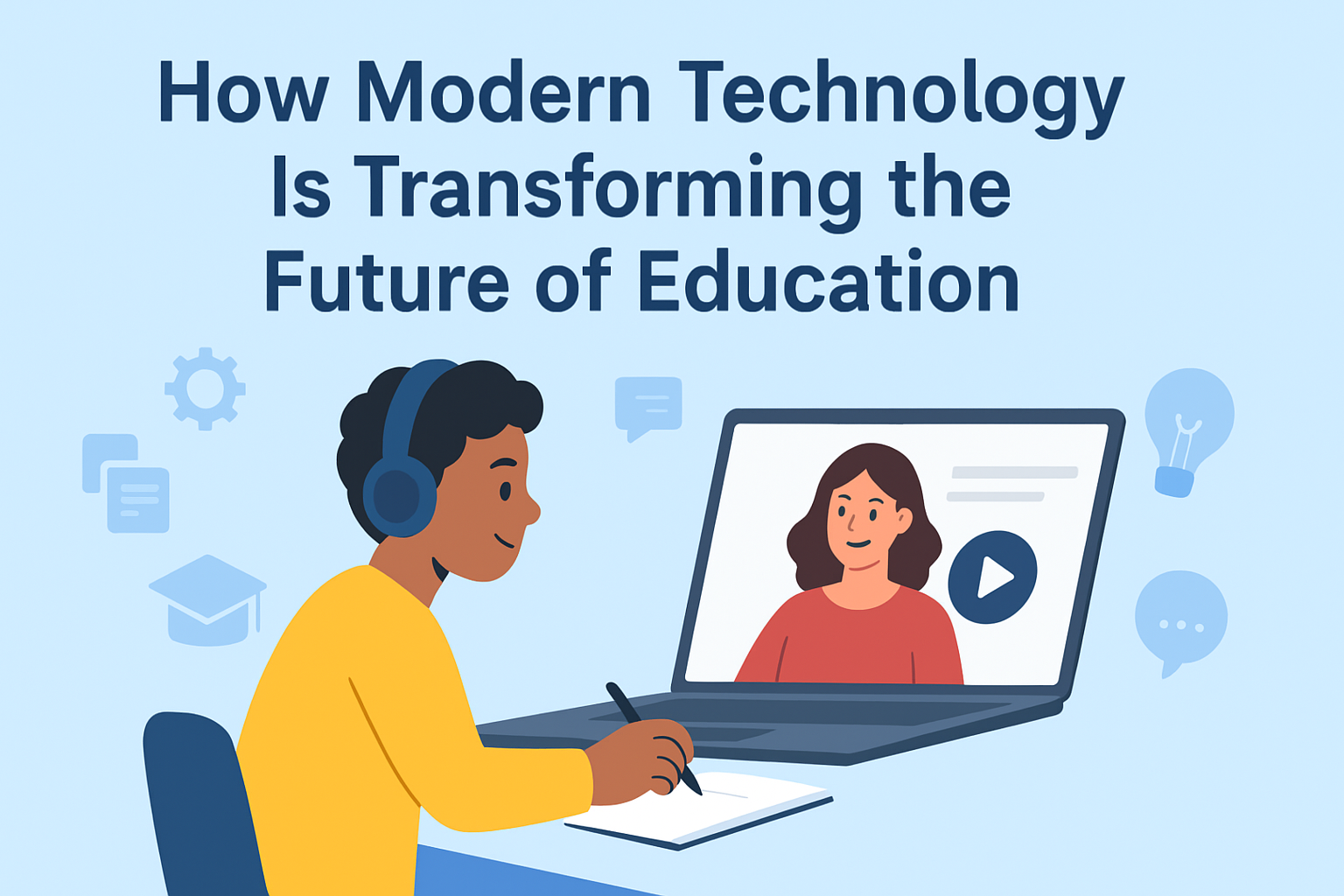
How Modern Technology Is Transforming the Future of Education
Education has always been a driving force behind progress. For centuries, the classroom model remained largely unchanged: teachers lectured, students took notes, and exams measured success. But in today’s digital age, technology is transforming this model into something far more dynamic, interactive, and personalized.
In 2025, modern technology continues to revolutionize the way students learn, teachers instruct, and institutions operate. From artificial intelligence (AI) and virtual classrooms to gamification and digital resources, technology is shaping the future of education in profound ways.
This article explores the key ways modern technology is reshaping education, highlighting the benefits, challenges, and long-term impact on learners worldwide.
1. Artificial Intelligence in the Classroom
Artificial intelligence has become one of the most powerful tools in education. AI-driven platforms analyze student data to provide personalized learning paths. For example, if a student struggles with algebra but excels in geometry, the system automatically adjusts assignments and suggests targeted resources.
AI also supports teachers by automating tasks like grading, scheduling, and attendance tracking. This frees educators to spend more time on teaching and mentorship rather than administrative duties.
By 2025, AI-powered virtual assistants are also guiding students with real-time feedback, answering questions instantly, and recommending study techniques tailored to individual needs.
2. Online and Hybrid Learning Models
The global pandemic accelerated the adoption of online learning, and today, hybrid education (a mix of in-person and online classes) is becoming the new normal. Modern platforms like Zoom, Microsoft Teams, and Google Classroom have evolved to support immersive digital classrooms, where students can interact, collaborate, and even perform lab experiments virtually.
In 2025, online learning is no longer just a backup option—it is a mainstream educational model. Students can attend lectures from world-class professors anywhere in the world without leaving their homes, giving them access to opportunities that were once limited by geography.
3. Virtual Reality (VR) and Augmented Reality (AR)
One of the most exciting advancements in education is the use of VR and AR. These technologies create immersive learning experiences that bring abstract concepts to life.
- In VR, students can explore the solar system, walk through historical events, or perform virtual science experiments.
- In AR, textbooks and worksheets come alive with interactive 3D models and visual explanations.
For example, instead of reading about the human heart, students can examine a 3D beating heart in real time. These tools improve understanding, increase engagement, and make learning more memorable.
4. Gamification and Interactive Learning
Gamification—using game-like elements in education—has become a powerful way to motivate students. Points, badges, leaderboards, and challenges make learning competitive and fun.
Educational apps like Duolingo, Kahoot!, and Quizlet use gamification to keep learners engaged. In classrooms, teachers now use gamified systems to reward participation and encourage problem-solving.
This interactive style of learning not only increases motivation but also helps students retain information longer. By 2025, gamification is a core element of digital education, turning lessons into exciting, goal-driven experiences.
5. Big Data and Learning Analytics
Modern education generates massive amounts of data—from test scores and attendance to student behavior and participation rates. Through big data analytics, schools and universities can now gain valuable insights into learning patterns.
For instance, data can reveal which teaching methods are most effective, which students need extra support, and which topics are most challenging. This allows educators to make informed decisions and improve learning outcomes.
In 2025, many schools use real-time analytics dashboards to track student progress and adapt teaching strategies instantly. This data-driven approach makes education smarter and more efficient.
6. Cloud-Based Learning and Digital Libraries
The rise of cloud technology has given students instant access to a world of knowledge. With cloud-based platforms, learning materials, assignments, and resources can be stored and shared anytime, anywhere.
Instead of carrying heavy textbooks, students can access digital libraries filled with e-books, journals, and research papers. Teachers can also collaborate on lesson plans, track student submissions, and provide instant feedback.
Cloud systems not only improve accessibility but also ensure collaboration across borders, connecting learners and educators from around the globe.
7. Mobile Learning and Microlearning
In the age of smartphones, education is literally in the palm of our hands. Mobile learning apps allow students to study on the go, whether they’re commuting, waiting in line, or at home.
Microlearning—short, bite-sized lessons delivered through apps—has also become popular. Students can complete a 5-minute lesson during breaks instead of committing to hour-long lectures.
By 2025, mobile learning is one of the most flexible and accessible forms of education, helping students balance studies with busy lifestyles.
8. Collaboration Through Global Classrooms
Technology has eliminated classroom walls, creating global learning environments. Students can now join international study groups, work on projects with peers from different countries, and attend lectures from universities thousands of miles away.
This global collaboration builds cross-cultural skills, preparing students for careers in a connected world. It also exposes learners to different perspectives, making education more inclusive and diverse.
In 2025, virtual exchange programs are replacing traditional student exchanges, saving time and costs while still offering cultural immersion.
9. Automation and Smart Campuses
Modern campuses are becoming smart ecosystems. Automated systems control lighting, security, and attendance, while AI chatbots answer student questions about schedules, fees, or assignments.
Some universities also use blockchain technology to issue secure, verifiable digital certificates and diplomas. This reduces fraud and makes it easier for employers to verify qualifications.
Smart campuses not only improve efficiency but also provide students with a high-tech learning environment that mirrors the digital workplace.
10. Preparing Students for the Future Workforce
Perhaps the most important transformation is how technology prepares students for the jobs of tomorrow. The future workforce demands skills in coding, data science, AI, cybersecurity, and digital communication.
Through online courses, virtual labs, and simulations, students can gain hands-on experience in these areas before entering the job market. Technology-driven education ensures they are not just learning theory but also developing practical skills that employers value.
Challenges of Technology in Education
While technology brings enormous benefits, it also poses challenges:
- Digital Divide – Not all students have equal access to devices and high-speed internet.
- Distractions – Mobile devices can lead to reduced focus if not managed properly.
- Overdependence – Relying too much on technology may reduce critical thinking and creativity.
- Teacher Training – Educators must constantly learn new tools to keep up with evolving technology.
Addressing these challenges is crucial to ensure that the benefits of modern education are equally distributed and sustainable.
Conclusion
Modern technology is not just transforming education—it is redefining it. With AI, VR, online platforms, gamification, and global connectivity, students today have more opportunities than ever before. They can learn anytime, anywhere, and in ways tailored to their unique needs.
The future of education is one where technology and human creativity work hand in hand, preparing students for a world that is fast-changing and digitally driven. While challenges remain, the possibilities are limitless.
As we move deeper into 2025 and beyond, it’s clear that technology will continue to be the engine driving the evolution of learning, shaping smarter students and stronger societies.

